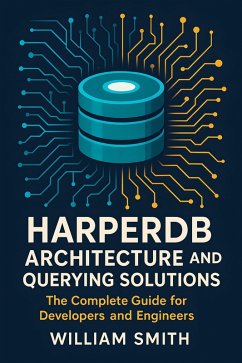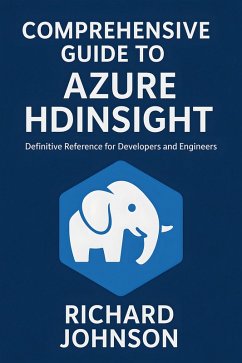
Comprehensive Guide to Hive Architecture and Query Language (eBook, ePUB)
Definitive Reference for Developers and Engineers

PAYBACK Punkte
0 °P sammeln!
"Comprehensive Guide to Hive Architecture and Query Language" This expertly crafted volume offers a sweeping exploration of Apache Hive, tracing its evolution from its early origins alongside Hadoop to its current standing as a cornerstone in modern data warehousing. Readers are guided through the historical motivations behind Hive's design, its unique differentiators compared to other analytical platforms, and its integration within both traditional and cloud-native environments. The book not only contextualizes Hive's role amongst emerging data processing engines such as Presto, Impala, and ...
"Comprehensive Guide to Hive Architecture and Query Language"
This expertly crafted volume offers a sweeping exploration of Apache Hive, tracing its evolution from its early origins alongside Hadoop to its current standing as a cornerstone in modern data warehousing. Readers are guided through the historical motivations behind Hive's design, its unique differentiators compared to other analytical platforms, and its integration within both traditional and cloud-native environments. The book not only contextualizes Hive's role amongst emerging data processing engines such as Presto, Impala, and Spark SQL, but also presents real-world deployment patterns, use cases, and future-facing trends, establishing a solid foundation for readers seeking to understand Hive's place in today's data ecosystem.
Delving into the heart of Hive's technical architecture, the guide provides a profound examination of core components including the Metastore, query compilation and optimization processes, execution engines, and robust fault tolerance mechanisms. Coverage extends into advanced data modeling techniques-partitioning, bucketing, and schema evolution-as well as best practices for storage optimization and metadata governance. Readers will gain practical skills in designing performant data warehouses, leveraging Hive's strengths in balancing manageability, scalability, and extensibility, while implementing secure, compliant, and multi-tenant environments.
A substantial focus is also placed on Hive Query Language (HiveQL), equipping practitioners with in-depth knowledge of syntax, advanced analytical patterns, custom functions, and transactional semantics. The book bridges theory and practice with comprehensive discussions on query optimization, performance engineering, workload management, and sophisticated integration scenarios with BI tools, streaming data, Spark SQL, and federated sources. Concluding with chapters on deployment strategies, operational best practices, and emerging innovations such as serverless Hive and data lakehouse architectures, this guide stands as an indispensable resource for architects, engineers, and data professionals striving for mastery of large-scale analytic data platforms.
This expertly crafted volume offers a sweeping exploration of Apache Hive, tracing its evolution from its early origins alongside Hadoop to its current standing as a cornerstone in modern data warehousing. Readers are guided through the historical motivations behind Hive's design, its unique differentiators compared to other analytical platforms, and its integration within both traditional and cloud-native environments. The book not only contextualizes Hive's role amongst emerging data processing engines such as Presto, Impala, and Spark SQL, but also presents real-world deployment patterns, use cases, and future-facing trends, establishing a solid foundation for readers seeking to understand Hive's place in today's data ecosystem.
Delving into the heart of Hive's technical architecture, the guide provides a profound examination of core components including the Metastore, query compilation and optimization processes, execution engines, and robust fault tolerance mechanisms. Coverage extends into advanced data modeling techniques-partitioning, bucketing, and schema evolution-as well as best practices for storage optimization and metadata governance. Readers will gain practical skills in designing performant data warehouses, leveraging Hive's strengths in balancing manageability, scalability, and extensibility, while implementing secure, compliant, and multi-tenant environments.
A substantial focus is also placed on Hive Query Language (HiveQL), equipping practitioners with in-depth knowledge of syntax, advanced analytical patterns, custom functions, and transactional semantics. The book bridges theory and practice with comprehensive discussions on query optimization, performance engineering, workload management, and sophisticated integration scenarios with BI tools, streaming data, Spark SQL, and federated sources. Concluding with chapters on deployment strategies, operational best practices, and emerging innovations such as serverless Hive and data lakehouse architectures, this guide stands as an indispensable resource for architects, engineers, and data professionals striving for mastery of large-scale analytic data platforms.
Dieser Download kann aus rechtlichen Gründen nur mit Rechnungsadresse in A, B, BG, CY, CZ, D, DK, EW, E, FIN, F, GR, H, IRL, I, LT, L, LR, M, NL, PL, P, R, S, SLO, SK ausgeliefert werden.













